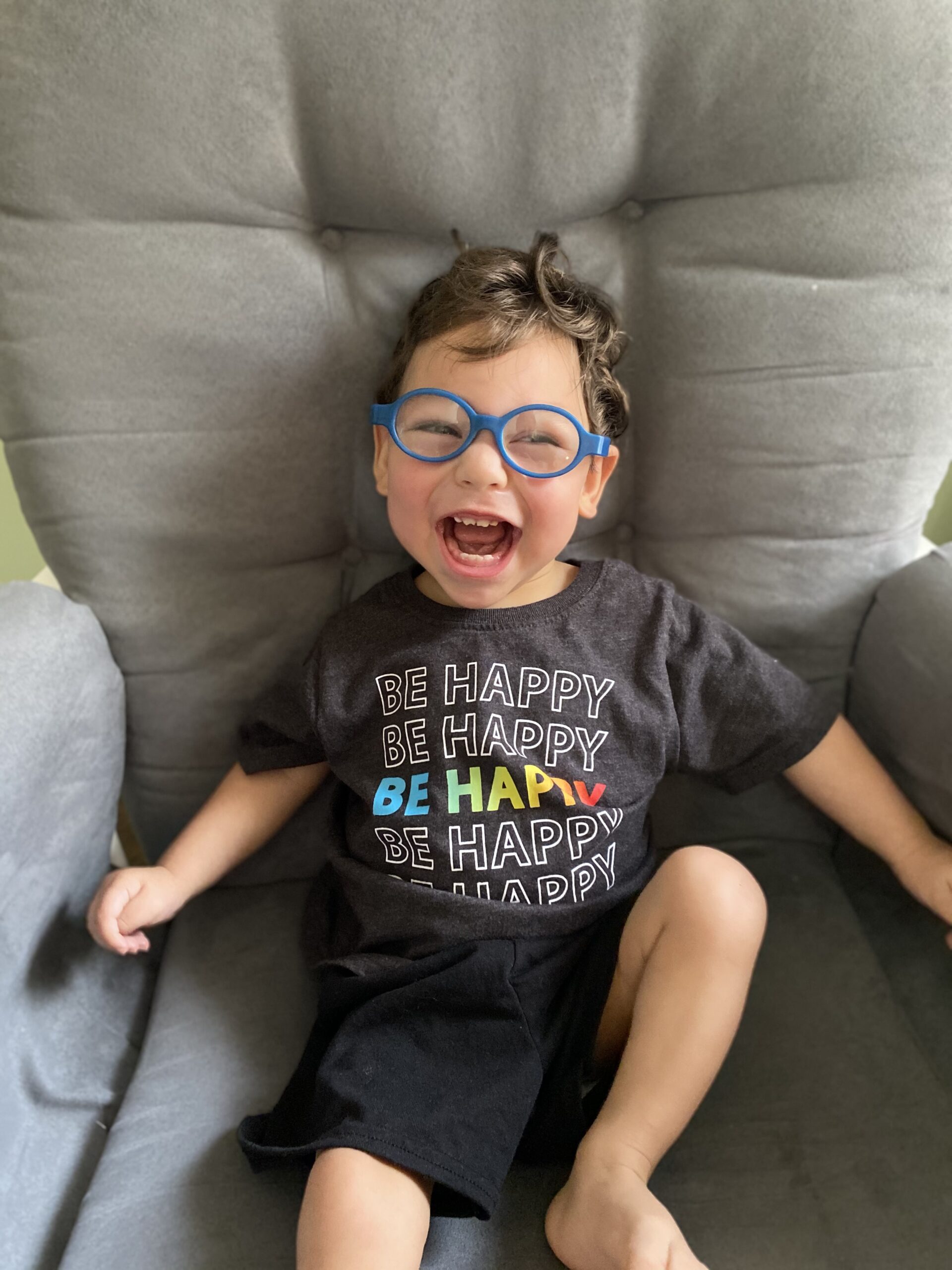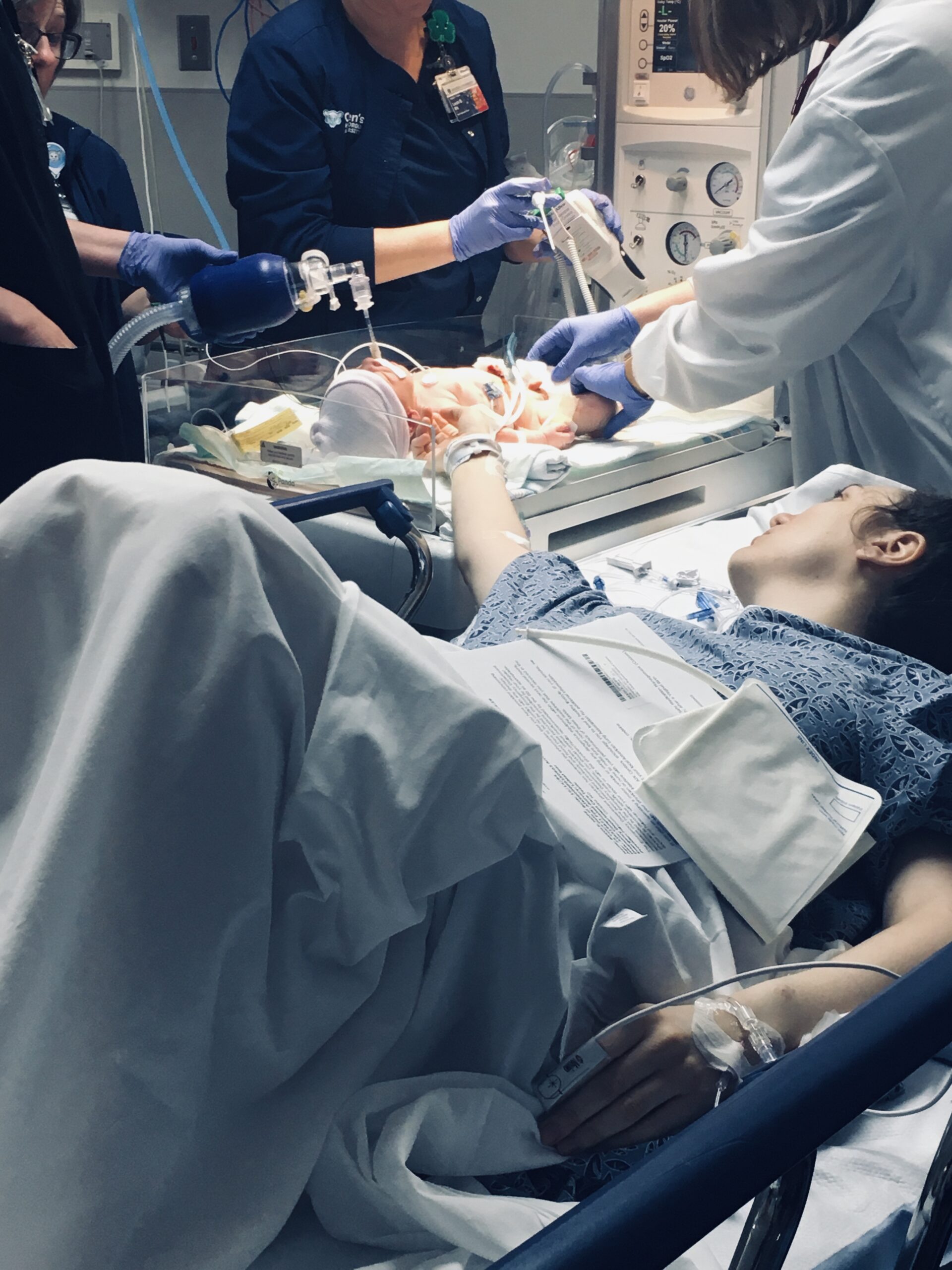
Name: Hope Beedle
Location: South Carolina, United States
Child’s Birth Year: 2020
Keywords: Single Parent, Advocacy Work/Blogging, Seizures/Epilepsy, Cerebral Palsy, Communication Challenges
As a single mother whose first child was born with severe HIE in the era of COVID-19, Hope has experienced firsthand the immense isolation associated with raising a medically complex child. But she has also experienced firsthand what true support looks like, whether through her mother always being there to serve as an extra set of hands or through the parents in the Hope for HIE community who are so willing to pass along their wisdom and advice.
Logan was born on Friday, March 13, 2020. His birth story is certainly a whirlwind of chaos, perhaps proof that there is some truth to the Western superstition of “Friday the thirteenth” being unlucky. After Hope went into labor, she didn’t have time to make it to the hospital, so Logan was born at home. Almost immediately, it was apparent that he was in distress. Because he had aspirated so much meconium, Logan went into cardiac arrest, turning blue, unable to breathe on his own. As adrenaline and fear surged through Hope’s body, she did CPR on Logan for the five minutes, until the first responders arrived.
At the hospital, Logan was stabilized, but he had already gone without oxygen for around an hour. A transport team took Logan to a children’s hospital in Georgia to receive cooling. Hope was utterly terrified. Everything had happened so fast—from the birth to the cardiac arrest—that she didn’t have time to process anything. On top of all the stress with Logan’s health, Hope herself had lost over 25% of her blood volume, so she needed a transfusion. Because of her condition, Hope wasn’t able to be in the NICU by her baby boy’s side until the next day. Fortunately, Hope’s mother was able to follow the transport team so Logan wasn’t alone.
During cooling, Logan had numerous seizures, so things looked grim. Then, when Logan’s MRI results came back after cooling, this grimness was only enhanced. The scan showed the basal ganglia was most affected, with damage to the occipital lobe as well. Hope was told that Logan would have a “devastating outcome” and to not expect him to do much of anything in his life.
Throughout Logan’s sixteen days in the NICU, most of the nurses were amazing, but many of the doctors didn’t take the time to bond with Logan or Hope. While some of the attendings coddled and made sweet talk to the premature babies in the NICU, that same warmth was not bestowed upon Logan. It felt like they had given up on him, telling Hope, before the cooling had even finished, to not expect to bring him home. Moreover, none of the providers ever gave Hope informational or support resources, so she felt in the dark and powerless as a mother.
When Logan was discharged from the hospital, it was as if Logan and Hope were just shoved out with the parting words of “see ya.” No one approached Hope to book follow-up appointments or direct her to early intervention services. Even though some of this lack of communication and consistent care was due to the pandemic just beginning, that still didn’t make it right.
To healthcare providers interacting with HIE families, Hope would tell them to, of course, share their medical information, but to do it in a way that doesn’t take away every trace of hope from a family. Just because a life with disability may seem like a “devastating outcome” to you, that doesn’t mean you have to explicitly share your personal opinion using those harsh words. Of course, having a child with disabilities is not ideal, but that doesn’t mean it’s the worst thing in the world either. Yes, Logan’s life may not look “typical,” but it’s far from devastating. And, especially with infants, while the unknown is scary, there is also hope that can be found in the unknown. With neuroplasticity, there is great potential for regrowth and adaptation of the brain as a child develops. In the end, that dark picture the NICU providers painted didn’t hold true for Logan. An MRI of the brain is a portrait taken at one moment in time, not one that is set in stone.
Because Logan was essentially discharged with no plan for follow-up care, the transition home was confusing and isolating. The pandemic made it harder for Hope to find local support resources. For a while, Hope tried to convince herself that the worst of Logan’s problems were behind them. Then Logan developed infantile spasms (IS) at four months old. Logan’s battle with IS was terrifying, having upwards of three hundred seizures a day. If Hope hadn’t found Hope for HIE a month prior to this seizure onset, she doesn’t know what she would have done. The information she found through Hope for HIE’s educational videos on IS was invaluable. Whenever she posted questions about seizures or IS, parents were quick to respond or offer her words of encouragement.
Before finding Hope for HIE, Hope didn’t know anyone else in her circle of friends or family who had experienced anything like what she was going through with Logan. She found unparalleled comfort in knowing there were thousands of families, all across the globe, who understood the fear and trauma she lived with daily. After seeing pictures in the support forum of older children who had learned to thrive in their own ways, Hope began to acknowledge that Logan might not be a child with no long-term effects. But, even if Logan did go on to be diagnosed with cerebral palsy or learning disabilities, it was going to be okay, no matter what happened.
In addition to Hope for HIE, the biggest game-changer in Logan’s struggle with IS was switching neurologists when he was six months old. The practice they had been going to in Charleston misdiagnosed Logan’s infantile spasms, increasing his dosage of phenobarbital, instead of giving him the appropriate medication. It was clear that Logan’s original neurologist didn’t take the time to consider Logan’s unique circumstances. Once Hope made the decision to transfer Logan’s neurology care to Le Bonheur Children’s Hospital in Memphis, Tennessee—one of the few hospitals in the nation that has an epilepsy center specializing in IS—all the weight she had carried for so long lifted off her shoulders. Even though the drive was much further, Hope finally had the confidence and comfort of knowing that Logan was receiving the absolute best care possible. And, almost right away, the new neurologist started Logan on adrenocorticotropic hormone (ACTH) medication, making a world of a difference.
Hope would tell other HIE parents this: Advocate for your child above all else. If you feel like a doctor or therapist isn’t caring about your child or listening to your concerns as much as they should, don’t be afraid to get a second, third, or even fourth opinion. It was hard for Hope to come to terms with the fact that the team Logan started off with in the NICU might not be the right fit for them. But, since making that difficult, but ultimately right, decision to transfer Logan’s care, Hope has flourished in her advocacy. She has never felt so empowered, as both a mother and a person.
Now, over one year into this journey, Logan truly is Hope’s feisty spitfire of a boy. Despite all he has been through, he is constantly smiling (other than when he’s teething). It’s hard not to feel joy when you’re around Logan. Cognitively, he is only around two months behind a neurotypical baby. He talks, understands what people around him are saying, and definitely knows how to manipulate others with his cuteness. Because he regressed in his motor abilities due to his two bouts of IS, Logan is affected physically. He is, however, on the verge of crawling—his legs know what to do, but he has more trouble with his arms. Hope sees how determined Logan is, each and every day, so she has faith that he’ll eventually be mobile to some degree. Even if Logan never quite gets there, Hope knows he will learn to adjust and adapt to his circumstances with grace.
For her, hope looks like a little boy being able to do whatever he wants. If Logan wants to follow in the footsteps of his father and play baseball when he gets older, Hope will not let his diagnosis limit him. Even if Logan might need to play from a wheelchair, he can still experience all those same joys of being part of a team. Hope sincerely believes that, with a little adaptation, children with disabilities are capable of doing amazing things. She is so grateful for the technology nowadays to help them unleash their full potential. And, in the end, Hope tells herself that Logan is who he was meant to be. Though she wishes he wasn’t forced to be so strong on a daily basis, she wouldn’t trade her resilient baby boy for the world.
Despite all the trials and tribulations, Hope will forever be grateful that Logan came into her life. Because of Logan, Hope is more patient and empathetic, acknowledging that disabilities do not detract from the value of a human life. Because of Logan, Hope has newfound confidence in herself, realizing that, even though she is a single parent, she is fully capable of giving her baby boy the best life possible. And because of Logan, Hope has learned how to use her voice and emerge as a fierce advocate, not only for her son, but for all children with disabilities. Hope will continue to share Logan’s story to spread awareness about disabilities in hopes that the coming years will ring in a new era of accessibility and inclusivity for all. Hope will continue to support other parents in their journeys, too, for she knows just how isolating and daunting life with HIE can be.
Most of all, regardless of what Logan’s outcomes will be as he grows older, Hope will continue to unconditionally love him and hold onto her namesake—hope itself.


Connect with families, read inspiring stories, and get helpful resources delivered right to your inbox.